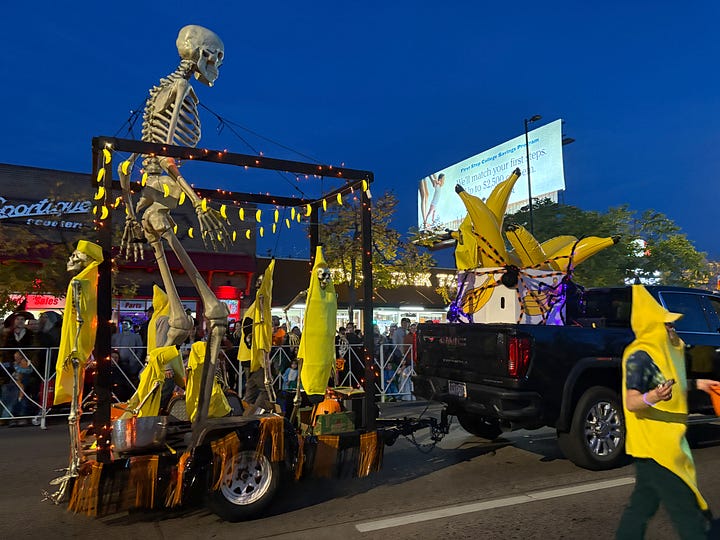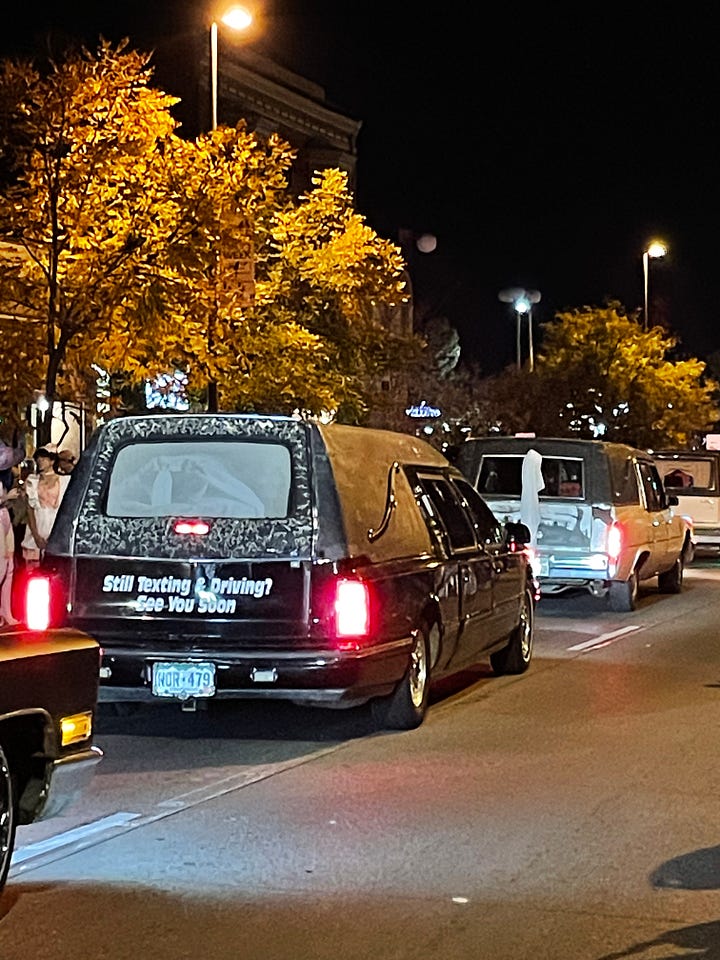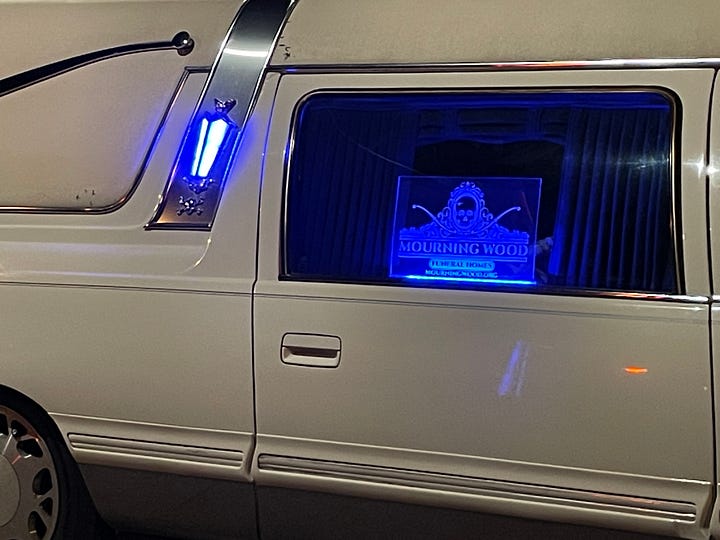Ode to Halloween
An appreciation of hearse clubs, ancient pagan rituals, and zombies giving candy to young children
This is the best time of year in my historic neighborhood in Denver. The old brick houses, the big, mature trees with their golden leaves against the blue skies in the gorgeous fall light. Lawns decorated with giant spiders and skeletons, with tombstones and grim reapers. Somehow, old neighborhoods just fit the vibe of autumn.
I’m not normally a big fan of parades. But there’s an annual Halloween parade within walking distance of my house that has become a huge community event, and one of my favorite traditions every year.
The parade covers the full spectrum from wholesome to unwholesome, with floats from local library staff, a few of the neighborhood schools, groups of dog owners (like the Denver Pug Posse, featuring dozens of pugs in costume), the axe-throwing place, and the sex shop on South Broadway (which has vague enough branding that the kids don’t know what it is), among many others. A dance studio performs Michael Jackson’s Thriller. Some years, the tattoo shop on the parade route gives out candy. Tons of kids are there, and they love it.
The fact that we all think of this as a fun, kid-friendly event is a little strange, if you stop and think about it. Everyone acts like it’s perfectly normal for a bloody zombie to walk down the street and give candy to a 3-year-old.




Everyone acts like it’s perfectly normal for a bloody zombie to walk down the street and give candy to a 3-year-old.
And there are hearses in the parade. Dozens of them. Hearse after hearse after hearse. Some decorated, with features like shooting flames. Some open with coffins inside. Some just plain old hearses driving by.




Did you know that there are clubs for people who own hearses1 all over the U.S.? Groups of people who come together because they enjoy driving cars that were made to carry dead bodies in coffins. It’s true; it’s a thing.
I’m fascinated by this. Who are these people? What compels them to buy a hearse and join a club with their fellow hearse owners? Where do they keep their hearses the rest of the year? Do they drive them around town to do errands? Or save them for events like the annual Halloween parade?
I hope I don’t sound judgmental. If you enjoy owning a hearse, I don’t see why not. I just didn’t know this was a thing until I started going to the parade, and I am genuinely intrigued.
A Seasonal Break from Death-Avoidance
One reason I’m intrigued is because it’s quite a counter-cultural thing to do. Here in the United States, we have a generally death-avoidant culture. We like to pretend that death isn’t going to happen to us. We don’t want to think about it, and we certainly don’t want to talk about it.
Mortality salience2 is the opposite of death avoidance. It’s the awareness and acknowledgement of the inevitability of death for all of us. On Halloween, mortality salience is all around - the front yard tombstones, the giant skeletons, the blood and guts, the horror films we have the urge to watch in October, the haunted houses.
Perhaps the playful spirit of Halloween makes light of death, in a slightly death-avoidant way. But to some degree, Halloween looks death squarely in the eye. At least we’re acknowledging it for a change!
A Brief History of Halloween (and Why It Matters)
Halloween has origins in the pagan festival Samhain, which marked the end of harvest and the start of “the dark half of the year.” The Celts who celebrated Samhain believed that on the night of October 31st, the boundary between the living and the dead became blurred for one night, and the ghost of the dead could return to earth. They celebrated Samhain with sacred bonfires, burning crops, and sacrificing animals. They wore costumes - typically animal heads and skins.
Samhain marked the start of “the dark half of the year.” The boundary between the living and the dead became blurred for one night, and the ghost of the dead could return to earth.
Over the centuries, Christianity spread over Europe and the world and, yada, yada, yada (I’m paraphrasing centuries of complicated history3 here)… some of the traditions of Samhain persisted and became integrated with Christian holidays. All Saint’s Day and All Soul’s Day, on November 1st and 2nd, were dedicated to honoring the dead, and the evening before was known as “All Hallows Eve,” which included some of the ancient pagan rituals. And here we are. It’s morphed and changed over time, but Halloween is alive and well in many countries around the world.
And, many other holidays and festivals take place this time of year, in cultures and religions around the world.4 Día de Muertos, Diwali, Moon festival, Rosh Hashanah, Oktoberfest, and so on. Autumn is a time of rituals and holidays. Themes for these holidays vary, but often revolve around the end of harvest, death, remembrance of the deceased, the seasonal change into darkness, reflection, atonement, darkness and light, good and evil.
Jack-o-lanterns, trick-or-treating, costumes, ghosts, and witch hats... All of these Halloween customs have fascinating histories and rich symbolism.
Holiday traditions and rituals are important to humans. They connect us in meaningful ways to our pasts, our families, our communities. I remember my mom sewing costumes for me in the 80s, and trick-or-treating in the snow (as most Colorado kids from my era may remember). I remember houses getting pranked with t.p. and silly string. I remember classroom parties, and trading candy with my little sister.
As a parent myself now, I don’t have the skill or bandwidth to make homemade costumes, but tomorrow night I’ll bundle up and walk around in cold temperatures with my own kids as they trick-or-treat the neighborhood, just like I did decades ago.
These kinds of traditions also connect us with a greater humanity, that’s much bigger than ourselves. When you put on your werewolf costume, you are a part of the history of humanity over the centuries. You’re connected to people celebrating similarly-themed holidays around the world. And these shared experiences are an important part of what makes us human.
Halloween Today
Do we spend too many billions on Halloween? Sure, you could argue that it’s gotten out of hand, and become yet another consumerist, wasteful holiday, with too much money spent at the Halloween Spirit store, and the ten pound bags of Kit Kats and mini-Snickers you can buy at CostCo. Just look up the statistics on how much money American spend on costumes for their pets, and you’ll see how ridiculous it’s become.
But let’s look at a couple more important things Halloween gives us:
It’s the ultimate community holiday. We’ve collectively decided that one night a year, we’re going to let kids and teenagers go around the neighborhood and knock on doors they wouldn’t normally go near. We’ll give each other treats, just because that’s what we do on October 31st. We’ll greet each other on the street, and exchange compliments on decorations and costumes. We’ll have parties and go to bars in costumes. We’ll do these things one night every year, because we’ve agreed to it as a collective. And everyone is welcome to participate!
It’s a chance for us to be creative and weird. This time of year, we can let our “freak flags fly” with no judgment. If you want to dress in drag or wear something scary or funny or sexy, go for it! Paint your entire body green if you want. The wilder the costume the better. If you want to set up an elaborate scene of creepy weirdness in your front lawn, do it! You’ll be admired. It’s a time of year when we can drive a hearse in a parade with our friends, and people will cheer for us. Even people who normally wouldn’t do any of these things might go all out on Halloween, and have fun doing so.
So, as we get our candy bowls ready, and light our jack-o-lanterns tomorrow, let’s remember that our Halloween traditions are tied to centuries of history, and to many cultures around the world. This is about the change of season from darkness to light, a celebration of the descent into dark winter ahead. It’s about remembering death, a reality that happens to us all.
And remembering that we will die (Memento Mori!) reminds us that we are alive, and that it’s important to pause and appreciate life now.
Happy Halloween!
P.S. Well wishes to all for the truly terrifying event coming up next week: The U.S. Presidential Election! If you could use it, a few months ago I wrote a blog post on coping with election stress.
After I shared this post, my husband found this article about the start of Denver’s hearse club in 1996!
You should listen to this podcast episode with Jodi Wellman about her book You Only Die Once for more on the topic of mortality salience!
I’m trying not to go on too long about the history of Halloween in this essay, but it’s really interesting! Here are a few references, if you want to go down a rabbit hole:
I hope readers in the southern hemisphere will forgive my northern-biased perspective here. Happy spring!




Your story makes me appreciate Halloween even more.